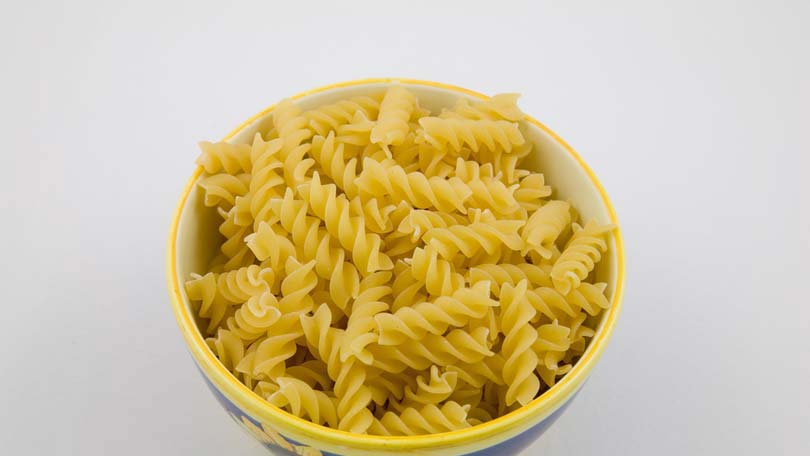
As anyone cruising down the spaghetti aisle in a supermarket can attest to, pasta comes in a large variety of shapes and sizes. The Italian word pasta comes from ‘paste,’ which is what the mixture of wheat flour, egg, and water looks like before it is kneaded into different forms. Mainly, there are two types of pasta – fresh and dried; while either can be found in almost any market, the dried pasta is available in a huge array of shapes, but the fresh pasta is available in a wider variety of flavors.
Fresh pasta is usually found in the refrigerated or freezer section of a grocery store because it contains eggs. More delicate than dried, fresh pasta is softer and can be cooked for a shorter time, only swelling a slight amount during boiling. It is more difficult to store than dried pasta as it must be used within three to four days if refrigerated, and one to two months if frozen. Because fresh pasta contains eggs, it offers a higher nutritional content and better flavor than dried pasta. Common ingredients added to the fresh pasta dough are spinach, garlic and herbs, tomato, and curry.
Dried pasta is very easily stored; it does not require refrigeration or freezing, and can be stored in a pantry indefinitely. It is most often made with water, salt, and semolina flour – no eggs – and is fully dried before packaging. Dried pasta must be cooked for a longer time than fresh pasta and swells a great deal during boiling. It has a firm texture even when cooked, so dried pasta works well in heavy sauces that contain meat or vegetables.
Pasta is made with flour, and the type of flour used can affect the flavor of the pasta as well as nutritional content. The three most common types of flour used in pasta are semolina flour, unbleached white flour, and whole wheat flour. Semolina flour, ground from hard durum wheat, is typically used in dried pasta. It has a large amount of gluten which makes the dough quite elastic, lending itself to shaping. Unbleached white flour is made from red winter wheat and produces lighter dough that is very easy to work with. Whole wheat flour is becoming more popular as consumers look for healthier pasta options, and is made from whole wheat grain. It produces nuttier tasting pasta that has a heavier texture than pasta made with unbleached flour.
Perhaps the most fun part of pasta is its availability in so many different forms. As a basic summary, there are shaped pastas, tubular pastas, ribbon pastas, strand pastas, stuffed pastas, and soup pastas. Some types are used for a certain purpose (like lasagna noodles), and some can be used in many different dishes. Because dried pasta is made with flour that lends well to shaping, dried pasta is used for macaroni, bow-tie, rotini, snail, and wheel shaped pastas. Other common dried pasta shapes are cavatelli, farfalle, fiori, gemelli, and rotelle. Dried pasta is also used to make tubular, strand, ribbon, and soup pasta. Most commonly, fresh pasta is available in strand, ribbon, or stuffed pasta form. Strand pasta can be thick or thin, square or rounded, and even wavy. Thin strand pasta goes well in delicate sauces while thicker strands are suited for heavier sauce. Ribbon pasta comes in different widths and lengths. A popular ribbon pasta is the lasagna noodle; fresh or dried ribbon pasta can be used in lasagna, but cooking time differs between the two. Stuffed pasta is also commonly made with fresh pasta that is stuffed with cheese, meats, herbs and vegetables, then folded and sealed before cooking. Some stuffed pasta is formed into squares to make ravioli or folded into triangles and twisted to make tortellini. While the flavor of the pasta dish is greatly influenced by the pasta sauce used, a lighter sauce with an olive oil base will allow the flavor of the dough to come through.
Pasta is a very affordable dish that is consumed by many families worldwide. A dried box of pasta can be purchased for under $1.00! Children love the different types of pasta – the spiral, wheel, and bow-tie shapes keep them interested, and even make good media for arts and crafts. First discovered centuries ago, pasta is a versatile food that can be fit into many types of dishes with any type of meat or vegetable. Remember during preparation that fresh pasta is more delicate and best suited for lighter sauces while dried is most often thicker and suited for heavier sauce. If you always eat the same pasta, get out there and try something new; there are too many pastas and sauces out there to only enjoy one kind!
